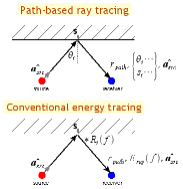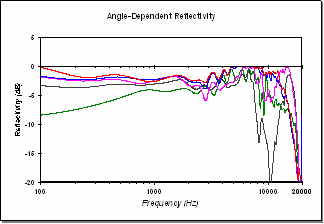simulation methods
|
 |
|
|
|
ray tracing for high-resolution
auralization
 In
response to the challenge of modeling the complex ceiling canopy, a new
high-resolution ray tracing engine was developed. This new set of
algorithms contains methodologies for simulating the early impulse response of the hall
with great accuracy. The new engine includes support for
fundamental acoustical phenomena frequently neglected in conventional
techniques, such as support for multi-order sound transmission, angular
dependence in reflection and transmission, and arbitrary frequency
resolution for materials-modeling filters.
In
response to the challenge of modeling the complex ceiling canopy, a new
high-resolution ray tracing engine was developed. This new set of
algorithms contains methodologies for simulating the early impulse response of the hall
with great accuracy. The new engine includes support for
fundamental acoustical phenomena frequently neglected in conventional
techniques, such as support for multi-order sound transmission, angular
dependence in reflection and transmission, and arbitrary frequency
resolution for materials-modeling filters.
The architecture chosen for the ray tracing engine is a path-based technique, where the ray
tracing (as a geometrical operation) is separated from the synthesis
technique (an acoustical operation). In conventional techniques,
the acoustical energy of each ray is tracked it travels through space,
and this energy is modified as it strikes boundary surfaces. With
a path-based tracing, the acoustical energy is not tracked during the
tracing operation, instead, the geometrical path of the ray is saved
into a database, including a list of surfaces that the ray encountered
as well as the angles-of-incidence of each hit. This provides
many benefits, the primary one being that the model does not have to be re-traced when
changing material properties.
|
Path-based
approach
|
Conventional
energy-based approach
|
Cumulative
ray data
|
Surfaces
encountered and incidence angles (geometrical)
|
Cumulative
energy of ray (acoustical)
|
Surface
properties
|
May
be modified without re-tracing the model
|
Re-tracing
required
|
Memory
requirement
|
High
(only early-part for realistic implementations)
|
Low
|
Material
Filters
|
Arbitrary
resolution (not required at runtime)
|
Fixed-resolution
(typically octave or 1/3rd-octave)
|
locating multi-order transmitted sound
paths
 Due
to the acoustically-transmissive nature of the overhead canopy in
EMPAC, an accurate model of sound transmission through the canopy is
required. Most commercially-available simulation techniques are
unable to accurately simulate multi-order sound transmission paths, due
to their use of stochastic energy-based techniques for multiple-order
transmissions. This research work applies the concept of ray spawning to deterministically
locate transmitted-sound paths. When a ray encounters a
transmissive surface, a child ray
is spawned at the surface that continues to search for valid paths
beginning on the opposite side of the surface. This guarantees that transmitted and
transmitted-reflected sound paths will be located up to a predefined
search order. Using ray-spawning techniques is highly
memory-intensive, and geometrical constraints must be employed on
transmission and reflection order so that the spawning operation does
not overrun available memory.
Due
to the acoustically-transmissive nature of the overhead canopy in
EMPAC, an accurate model of sound transmission through the canopy is
required. Most commercially-available simulation techniques are
unable to accurately simulate multi-order sound transmission paths, due
to their use of stochastic energy-based techniques for multiple-order
transmissions. This research work applies the concept of ray spawning to deterministically
locate transmitted-sound paths. When a ray encounters a
transmissive surface, a child ray
is spawned at the surface that continues to search for valid paths
beginning on the opposite side of the surface. This guarantees that transmitted and
transmitted-reflected sound paths will be located up to a predefined
search order. Using ray-spawning techniques is highly
memory-intensive, and geometrical constraints must be employed on
transmission and reflection order so that the spawning operation does
not overrun available memory.
|
Ray-spawning
approach
|
Stochastic
approach
|
Locating
paths
|
Spawning
of child rays at transmissive boundaries
|
Stochastic
transmission of groups of rays
|
Application
|
Guaranteed
location of multi-order early-part transmitted paths
|
Late-component
synthesis (reverberation)
|
Memory
requirement
|
High
(only early-part for realistic implementations)
|
Low
|
Runtime
constraints
|
Transmission
order (by number of parent rays)
|
None
|
high-resolution auralization synthesis
In addition to
the new ray-tracing and transmission techniques outlined above, the new
simulation engine contains the ability to perform high-resolution impulse response synthesis.
Typically, the synthesis of impulse responses from ray-tracing routines
is at a fixed frequency resolution (typically octave-band) and with no
angular dependence. The new technique utilizes the surface and
incidence-angle data from the path-based
ray tracer to allow for the use of material modeling filters of:
- Arbitrary frequency resolution
- Dependence on incidence angle for both transmission and reflection
This provides
unprecedented capabilities when synthesizing impulse responses,
allowing for much higher accuracies to be achieved in the modeling of
surface material properties. The ability to use arbitrary
frequency resolution allows for details in transmission and reflection
spectra to be revealed, and angular-dependent filters increase both the
accuracy of simulation and the plausibility of auralizations.

The synthesis algorithm permits
incidence-angle-dependent reflection and transmission filters with
arbitrary spectral resolution.
This
material is based upon work supported by eMPAC
at Rensselaer.
|
© 2004, Paul Henderson |



